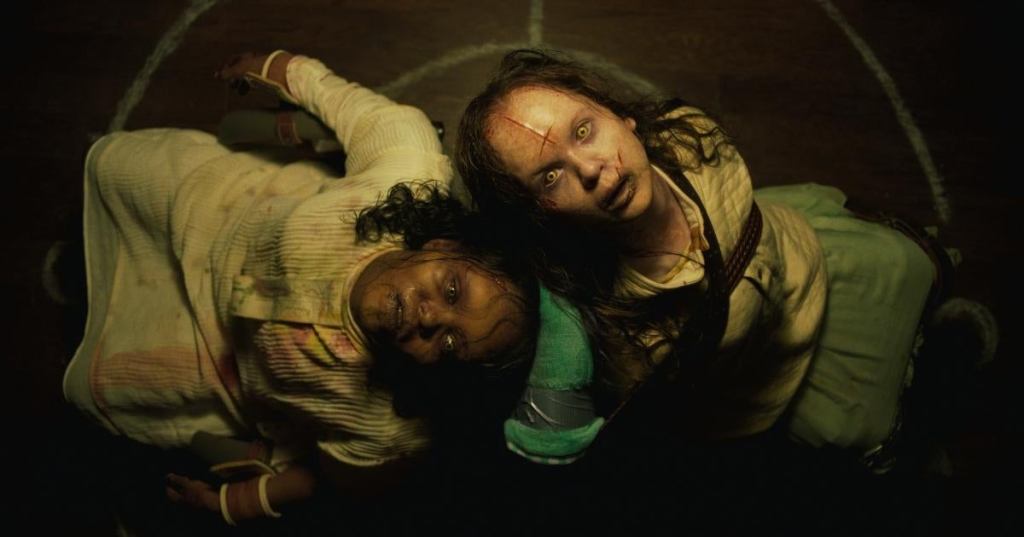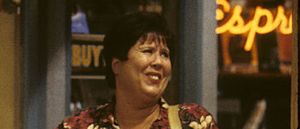David Gordon Green’s new horror credit The Exorcist: Believer is currently taking the box office by storm, officially crossing the $100 million landmark. Taking place 50 years after the original 1973 classic, the R-rated film from Universal and Blumhouse plunges viewers into a terrifying tale of possession after two girls return from a three-day disappearance, bringing with them frightening behavior and a horrific chain of events, brought to life, and evoking fear and disorientation in viewers through the stunning set design led by the film’s set designer, Brandon Tonner-Connolly.
Tonner-Connolly was no stranger to production design or to big projects. His past credits include The Big Sick, Extremely Wicked, Shockingly Evil and Vile, and Reservation Dogs, among many others, and as a self-declared “big horror fan” who had seen the original film “about a dozen times,” he told PopCulture.com that he “didn’t hesitate at all” when he was approached about The Exorcist: Believer. When it came to Believer, a film “in its own category because of the genre and the scale,” Tonner-Connolly said, “It’s so squarely in the horror genre, which I’ve always been a big fan of, and it’s part of such a giant blockbuster legacy the look had to have some spectacle to it.”
Videos by PopCulture.com
“I tried to incorporate that attention to detail into all the Exorcist sets, combining the need to create an atmosphere where horrific things could unfold with the mandate to let the spaces fill in the details of the character’s stories,” he shared. “What remnants of Angela’s mother did they still have in the house? What unfinished photo projects of Victor’s are off in the corner? What’s important enough for them to put up on the refrigerator and look at every day? We tried to keep all these questions in mind to hopefully draw the viewer into the movie’s world and connect with the people in it so they’re even more shocked and appalled when the horror starts.”
After connecting with Green for the project, the pair “started breaking down the script and talking about the different characters, the town of Percy, and the world of the movie in general.” Tonner-Connolly collaborated with Green throughout the film, including when it came to Victor’s house, a home filled with maze-like hallways that help disorient the audience. After finding the perfect exterior, a process that involved viewing dozens of homes in an attempt to find an exterior as “potent” as Chris McNeil’s house in the original Exorcist film, Tonner-Connolly got to work on the interior, prioritizing “making it a believable space that felt real for the characters and reflected their history” while also making it “feel confusing, like a maze.”
“I wanted there to be unnecessary twists, jogs, and doors where there wouldn’t necessarily be doors and a sense that you could get drawn deep inside and never find your way out. But it was important to balance the two. The worst thing I could imagine was creating a ‘haunted house’ that felt like it belonged in a horror movie,” he said. “One element we added was a kind of textured glass panel hanging between the living room and the dining room to add to the maze aspect of the house and give the DP something interesting to shoot through. Plus, all of Victor’s photography, remnants of Angela’s childhood, a million small pieces.”

Noting that “The Exorcist is such a landmark film, both in the genre and beyond,” Tonner-Connolly said that while “the locations, the time periods, and the stories” between the two films are “so different,” he wanted “to live up to the original in terms of how well the spaces were laid out. I wanted to give our movie the same opportunity to photograph so beautifully and always have something interesting in the frame without it feeling over the top.”
One inspiration he took from the original was the use of color, recalling the opening sequence of The Exorcist in Iraq, which has a “very different in tone from anything else in the film.” Tonner-Connolly said he “wanted our opening Haiti sequence to be similarly unique, for the colors to have a vividness that you don’t see for the rest of the movie.” He also said he “wanted our use of colors and our color palette to echo” the original film’s use of color to give viewers “a sense of discomfort.”
Tonner-Connolly was tasked with balancing those connections to and inspirations from the original Exorcist movie with the plot and subtext of Believer, a film that is set in Haiti after the devastating 2007 earthquake. Describing the task of accurately portraying the country “at that exact moment in time before and after the earthquake” as “a Herculean effort,” Tonner-Connolly said the team “gathered an insane amount of research on Haiti at that exact moment in time,” including images, photorealistic mockups, and creating hundreds of hand-painted signs.
Although the setting of the film is vastly different than The Exorcist, he explained that he “took inspiration from The Exorcist and knew this opening sequence needed to feel very different than the rest of the film. “I wanted Haiti to feel warm and vibrant, very different from the reality you’re dropped into after the earthquake, so you felt bereft of something like Victor did,” he said.
Through his research and collaboration, Tonner-Connolly helped bring to life the confusing, detail-driven sets seen throughout the movie. Among his favorite details, Tonner-Connolly said, were glimpses of the photographs seen throughout the movie that gave a nod to Victor’s photography career, something he had to put on hold after becoming a single parent to Angela. Tonner-Connolly said with those photographs, he “wanted to show his personal work, his passion, even if it’s been pushed aside by his responsibilities. Because that tells you so much about him and why we, as an audience, care about him.”
The Exorcist: Believer is now playing in theaters. The film is also available exclusively on digital platforms where you can rent or buy.








